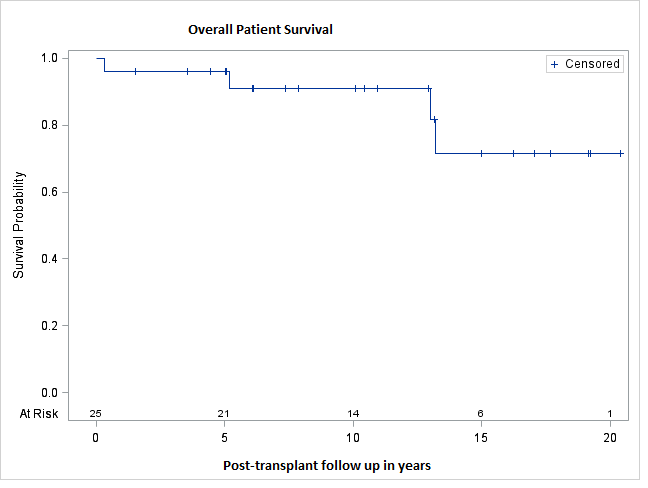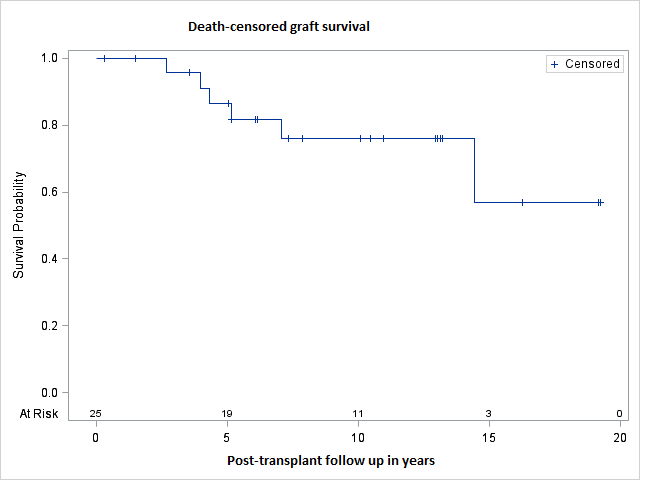Long-term Outcomes And The Feasibility Of Kidney Retransplantation In Pediatric Survivors Of Post-transplant Lymphoproliferative Disease
University of Minnesota, Minneapolis, MN
Meeting: 2019 American Transplant Congress
Abstract number: C238
Keywords: Lymphoproliferative disease, Retransplantation
Session Information
Session Name: Poster Session C: Kidney: Pediatrics
Session Type: Poster Session
Date: Monday, June 3, 2019
Session Time: 6:00pm-7:00pm
 Presentation Time: 6:00pm-7:00pm
Presentation Time: 6:00pm-7:00pm
Location: Hall C & D
*Purpose: Post-transplant lymphoproliferative disease (PTLD) is a serious and life-threatening complication of solid organ transplantation. Long-term graft outcomes and the feasibility of kidney retransplantation in pediatric survivors of PTLD have not been described.
*Methods: We retrospectively reviewed data on 388 kidney transplants that were performed in children, aged younger than 18 years, at the University of Minnesota between January 1, 1997 and September 1, 2017 to identify all cases of PTLD. We compared continuous and categorical variables using the Wilcoxon Rank-Sum test and the Fisher’s exact test, respectively. We examined patient and death-censored graft survival using the Kaplan-Meier methods.
*Results: Twenty-five patients developed PTLD over a median follow-up of 10.4 years (range: 0.3-20.4). Of the patients, 17 (68%) were male and 22 (88%) were white. Median age at transplant was 6.2 years (range: 0.9 – 17.4). Median time from transplant to PTLD was 1.3 years (range: 0.3 – 12.6). Graft and patient survival are shown in figures 1 and 2. Five patients lost their graft to rejection and one to recurrent disease. The median time from PTLD diagnosis to graft loss was 2.3 years (range: 1.6-6.7). Age at transplant, race and gender distributions were similar between patient who did and did not lose their graft (p > 0.05). Four patients died during the follow-up; 3 due to PTLD and 1 due to bacterial septicemia. Notably, all deaths occurred before 2001. Median time from PTLD to death was 1.2 years (range: 0.05-12.7). Five patients underwent kidney retransplantation and were followed for a median of 6.7 years (range: 1.6-13.1). Median time from PTLD to retransplantation was 4.4 years (range: 2.4 – 12.5). All retransplanted recipients received standard immunosuppression: thymoglobulin for induction, cyclosporine (3) or tacrolimus (2), and mycophenolate (3) or azathioprine (2) for maintenance immunosuppression. Only 1 patient had graft loss after 10 years due to calcineurin toxicity, but subsequently received a third transplant, which is still functioning. We observed no deaths in retransplanted patients. PTLD did not recur in any patient.
*Conclusions: PTLD recurrence is rare and kidney retransplantation is safe in pediatric survivors of PTLD.
To cite this abstract in AMA style:
Kizilbash S, Verghese P, Chavers B. Long-term Outcomes And The Feasibility Of Kidney Retransplantation In Pediatric Survivors Of Post-transplant Lymphoproliferative Disease [abstract]. Am J Transplant. 2019; 19 (suppl 3). https://atcmeetingabstracts.com/abstract/long-term-outcomes-and-the-feasibility-of-kidney-retransplantation-in-pediatric-survivors-of-post-transplant-lymphoproliferative-disease/. Accessed December 14, 2025.« Back to 2019 American Transplant Congress


